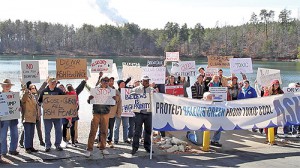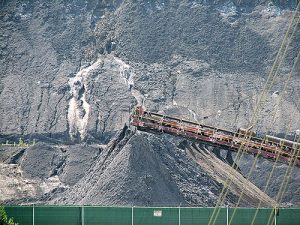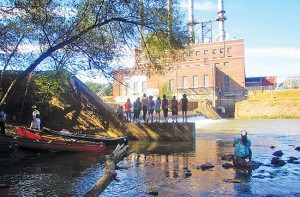Coal Ash Management
Long-Awaited, Still Debated
By Kimber Ray
——————————————————————————————————————————————
UPDATE: In the month after this issue of The Appalachian Voice went to press, the electric utility Duke Energy was issued two historic fines for violations of the Clean Water Act at its North Carolina coal ash sites. Read about the federal and state charges on the Front Porch Blog.
——————————————————————————————————————————————

Salem College biology students joined the Dan River Basin Association this January to help collect sediment samples for microbial analysis. Photo by Brian Williams
State regulators have known about toxic near Duke Energy’s coal-fired power plant in Salisbury, N.C., for years.
Since 2011, officials have disclosed more than 226 water quality test violations near the Salisbury plant that bear similarities to coal ash, the hazardous byproduct that remains after burning coal for electricity.
Of course, regulators decided to play it safe — for the power industry, that is. The N.C. Department of Environment and Natural Resources’ repeated claims that perhaps the pollution was simply a natural occurrence were a predictable line of defense when considering that historically, the regulatory directive on coal ash might as well have been “look away.”
Though that could prove a difficult feat for the second largest source of industrial waste in the United States, government officials have achieved this with astounding finesse.
Despite more than 150 federally acknowledged cases of water contamination and several notorious spills, measures such as water quality monitoring, safety inspections and protective liners for coal ash ponds remain rare on the state level and, until this past December, nonexistent on the federal level.
“There are plenty of people who say ‘I really don’t care, I just want a job,’” states Brian Williams, program manager for the Dan River Basin Association, which works to protect and promote that river. “And I understand that: people need to eat and they need a job. But they also need to drink, and you can’t live without water.”
The most recent high-profile coal ash spill occurred in North Carolina in February 2014, when more than 30,000 tons of ash emptied into the Dan River from a containment pond at Duke Energy’s retired coal-fired power plant in the city of Eden. Under the ensuing glare of public attention, last August state legislators passed what amounts to today’s toughest rules on coal ash in the nation.
North Carolina’s claim to regulatory fame is a source of major disappointment for many environmental and public health advocates across the country, who had hoped to see a stronger coal ash rule passed by the U.S. Environmental Protection Agency this December.

Despite the status of Duke Energy’s Belews Creek coal ash pond as the largest in the state, this site, located just 35 miles upstream from the Dan River spill site, is not slated for high-priority cleanup. On Jan. 31, local grassroots group Residents for Coal Ash Cleanup and Appalachian Voices gathered to protest continued inaction. Photo by Jaimie McGirt
The cumulative costs of weak coal ash regulations are tremendous. In a 2014 analysis of just five of Duke Energy’s 14 power plant sites in North Carolina, Dr. Dennis Lemly, a research biologist with the U.S. Forest Service and an associate professor at Wake Forest University, estimated that environmental and economic impacts totaled almost $2 billion.
“As far as what’s happening on the ground right now, there’s been no change [either nationally or in North Carolina],” Lemly says. “These rules still allow surface impoundments of coal ash, which is really the root of all evil in terms of fish and wildlife damage that we’ve seen for many, many years.”
Familiar Disappointments
Under the new federal rule passed this December, coal ash disposal will now be held to safety standards similar to those for household trash — and that’s an improvement. Unlike municipal landfills, coal ash waste sites were not historically required to have liners and, consequently, many don’t. The limited available data indicates that nearly all unlined ponds are seriously impairing nearby surface and groundwater with toxic levels of pollutants such as arsenic, lead, mercury and selenium.
“The EPA spent years developing this rule and turning up lots of evidence on how dangerous coal ash is,” says Pete Harrison, an attorney for the nonprofit Waterkeeper Alliance. “In the end, they gave in to intense political pressure and turned in an extremely weak and minimally enforceable rule.”
Although the federal rule sets minimum standards for the disposal and monitoring of coal ash, the EPA will neither enforce these regulations nor require states to do so. If a state chooses not to adopt the rule, the only enforcement will be through citizen litigation after a problem has already occurred.
States are free to take greater initiative and craft more restrictive standards, though on that front, North Carolina stands alone. Unlike the federal rule, the North Carolina Coal Ash Management Act could put an end to the nationally popular method of coal ash disposal — storage in unlined, wet surface impoundments — and the state will oversee enforcement.
But while all new coal ash waste produced by Duke Energy must be dried and stored in lined landfills, how the state law will address the utility’s existing 33 unlined surface impoundments remains to be seen. The state rule requires all coal ash ponds to close by 2029, but so far, only four are marked as high-priority and slated for relocation to lined landfills.
Closure plans for the other 29 sites, to be announced by the end of the year, may permit ash to remain in unlined ponds with an impermeable clay cap installed on top. This cap-in-place type of closure, also permitted by the federal law, could allow toxic waste to leach into groundwater indefinitely.
Another unresolved problem is where to relocate coal ash from Duke’s ponds that are being emptied out. The utility is already grappling with this issue at its four high-priority sites. Current plans to haul millions of tons of ash to landfills in Chatham and Lee counties have proven controversial, and residents continue to rally in opposition.

No effective controls prevent coal ash from blowing into the neighboring community at this combustion waste landfill, pictured left, near the Cane Run power plant in Jefferson County, Ky. Photo courtesy Kentuckians For The Commonwealth
Chronically Lax Oversight
Sites such as the Dan River are just the tip of the ashburg — a word used to describe the hulking masses of coal ash that decorate the scenes of spills. Although the exact number is unknown, more than 1,000 coal ash disposal sites are located in 37 states.
According to a 2011 analysis of state regulations by the nonprofit law organizations Earthjustice and Appalachian Mountain Advocates, some of the most dangerous and least-regulated ponds are in Appalachia. Low numbers of water quality violations in Kentucky may seem to indicate otherwise until considering that, as has been the case in most states, there are no groundwater monitoring requirements for coal ash disposal sites in Kentucky.
In Tennessee, more than six years have passed since a poorly constructed dam at the Kingston Fossil Plant collapsed and unleashed more than one billion gallons of coal ash across hundreds of acres and into two rivers. State officials have yet to enact even the most basic of regulations, such as annual inspections of massive containment dams like the one that failed.
Although this historic 2008 spill prompted the EPA to promise the nation’s first coal ash rule, it was a 2012 lawsuit brought by a coalition of environmental groups — including Appalachian Voices, the publisher of this paper — that brought the EPA to fulfill this promise in 2014.
Even if the rules had arrived sooner, however, it’s unlikely the new regulations could have prevented last year’s disaster on the Dan River. Final wording of the federal rule — which, at press time, had yet to be published — suggests that it would not allow the EPA to require the removal of coal ash from inactive ponds at shuttered facilities like the one that spilled.
No rule can mend the botched cleanup of the Dan River, which did not begin in earnest until six months after the spill. “The coal ash is now too buried by sediment to ever fully remove,” remarks Williams from the Dan River Basin Association.
Only about six percent of the coal ash was removed, but, with the ash now covered, Williams says water tests no longer show any levels of coal ash contaminants such as arsenic and mercury. This means the river is safe for recreational use such as paddling, but local residents remain concerned about the inevitable arrival of annual winter floods, which will stir up the coal ash and sweep it across adjacent farmlands.
Another concern is the gradual buildup of toxic contaminants in fish and wildlife. During the initial impact, many bottom-dwelling macroinvertebrates such as mussels, clams and crayfish were choked by the coal ash, and Williams has little doubt that conditions will worsen over time.
“There’s still a thousand-plus tons of coal ash in the river, so for the EPA to say [the river’s] back to pre-spill conditions is totally irresponsible,” Williams states.
Citizen Enforcement
One widely praised aspect of the federal rule is a requirement for all coal ash sites to install water quality monitoring wells within the next two years and disclose this data online in order to aid citizen enforcement.
“In some Southeast states right now, it can be next to impossible to get all the information about a given facility and understand what’s going on,” explains Harrison of Waterkeeper Alliance. “If you want records that should be public under federal law, you can’t go to a website like in North Carolina, you need to go to the agency office and stand there all day with a scanner and huge boxes of hard copy discs.”

Guilford College students, above, in front of the retired Dan River Steam Station during a river outing with the Dan River Basin Association in 2013. The association has long promoted citizen water quality testing as a vital component of healthy waterways. Photo by Brian Williams
Since North Carolina’s system was put in place in 2010, reports have revealed that sites at all 14 of Duke Energy’s coal-fired power plants have been polluting local water sources. This pre-existing water quality data for North Carolina sites may require the state to close coal ash impoundments earlier than current state-mandated deadlines because, once groundwater violations are discovered, federal law requires the facility to close within five years.
But, as Harrison warns, “It’s not quite so cut and dry. The federal law also provides second chances for the company to demonstrate that it has the problem under control in some other way.”
The validity of water quality data provided by the companies is also an important consideration. Aside from more notorious cases in which companies were caught altering water pollution reports, Judy Petersen, executive director for the Kentucky Waterways Alliance, says that accuracy is an issue. The federal rule requires a minimum of four wells, but that data’s usefulness depends on the location and depth of the wells, as well as whether the state agency has the resources to evaluate a company’s monitoring plans.
Continued Challenges
While representatives for utilities across the country supported the EPA’s decision not to classify coal ash as hazardous waste, they claim two aspects of the federal rule could prove particularly troublesome for estimating costs associated with coal ash. According to Harrison, some members of Congress have since proposed changes to address these concerns, such as prohibiting the EPA from ever returning to the rule to relabel coal ash as hazardous waste.
Combined with this effort is a push to limit legal avenues for citizen enforcement by requiring all states to adopt and enforce the federal rule, which would shift enforcement responsibilities to state agencies. In a recent testimony before the U.S. House Subcommittee on Energy and the Economy, Frank Holleman, senior attorney with the Southern Environmental Law Center, expressed his concerns about this proposal.
“We have seen, over and over again, that state agencies will not effectively enforce laws [related to coal ash disposal],” stated Holleman. “Without the citizen right to enforce the law, local communities cannot count on state agencies to effectively protect them.”
However the rules are enforced, Petersen of the Kentucky Waterways Alliance notes that her state faces additional challenges unaddressed by the law. Approximately 50 percent of Kentucky is comprised of karst, a rock formation easily dissolved by water that forms into extensive networks of caves and sinkholes.
“[Kentucky] coal ash sites never fill up, and part of the reason is because they’re leaking into the ground,” says Petersen. “If a karst cave development forms a sinkhole underneath a coal ash impoundment, it doesn’t matter if there’s a liner — it’ll take the liner and everything else with it.”
The Final Judgement
Some critics, such as The Center for American Progress, have suggested that implementation of coal ash rules could be problematic in the 39 states where judicial elections occur. Opportunities to “buy influence in the state courts” have continued to expand in recent years. A report published by the center last November found that North Carolina’s court was more likely to rule in favor of special interest groups who had given the largest campaign contributions to judge nominees.
In the long-run, Williams believes no rule will be a strong force for change until people reconsider how they value and monitor water quality. “We demand cheap power and energy,” he says. “Well, water is gold. It’s time we demand clean water, and more water protection.”
Learn more about coal ash, and listen to a discussion of North Carolina’s efforts to clean up coal ash with Amy Adams of Appalachian Voices.
Related Articles
Latest News
More Stories

Leave a comment
Your email address will not be published. Required fields are marked *





Leave a Comment